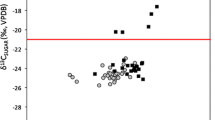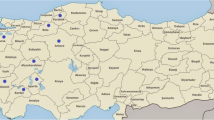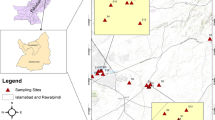Abstract
Coconut water is a natural isotonic, nutritive, and low-caloric drink. Preservation process is necessary to increase its shelf life outside the fruit and to improve commercialization. However, the influence of the conservation processes, antioxidant addition, maturation time, and soil where coconut is cultivated on the chemical composition of coconut water has had few arguments and studies. For these reasons, an evaluation of coconut waters (unprocessed and processed) was carried out using Ca, Cu, Fe, K, Mg, Mn, Na, Zn, chloride, sulfate, phosphate, malate, and ascorbate concentrations and chemometric tools. The quantitative determinations were performed by electrothermal atomic absorption spectrometry, inductively coupled plasma optical emission spectrometry, and capillary electrophoresis. The results showed that Ca, K, and Zn concentrations did not present significant alterations between the samples. The ranges of Cu, Fe, Mg, Mn, PO 3−4 , and SO 2−4 concentrations were as follows: Cu (3.1–120 µg L−1), Fe (60–330 µg L−1), Mg (48–123 mg L−1), Mn (0.4–4.0 mg L−1), PO 3−4 (55–212 mg L−1), and SO 2−4 (19–136 mg L−1). The principal component analysis (PCA) and hierarchical cluster analysis (HCA) were applied to differentiate unprocessed and processed samples. Multivariated analysis (PCA and HCA) were compared through one-way analysis of variance with Tukey–Kramer multiple comparisons test, and p values less than 0.05 were considered to be significant.



Similar content being viewed by others
References
Aleixo PC, Nobrega JA, Santos D, Muller PCS (2000) Direct determination of selenium in coconut water and coconut milk using graphite furnace atomic absorption spectrometry. Quim Nova 23:310
Buldini PL, Ricci L, Sharma JL (2002) Recent applications of sample preparation techniques in food analysis. J Chromatogr A 975:47
Campbell-Falck D, Thomas T, Falck TM, Tutuo N, Clem K (2000) The intravenous use of coconut water. Am J Emerg Med 18:108
Campos CF, Souza PEA, Coelho JV, Gloria MBA (1996) Chemical composition, enzyme activity and effect of enzyme inactivation on flavor quality of green coconut water. J Food Process Pres 20:487
Carvalho KM, Gallardo-Williams MT, Benson RF, Martin DF (2003) Effects of selenium supplementation on four agricultural crops. J Agr Food Chem 51:704
Chumbimuni-Torres KY, Kubota LT (2006) Simultaneous determination of calcium and potassium in coconut water by a flow-injection method with tubular potentiometric sensors. J Food Comp Anal 19:225
Coelho MAZ, Duarte ACP, Leite SGF (2002) Identification of peroxidase and tyrosinase in green coconut water. Cien Tecnol Alimen 3:266
de Sousa RA, Baccan N, Cadore S (2005a) Determination of metals in Brazilian coconut water using an inductively coupled plasma optical emission spectrometer. J Braz Chem Soc 16:540
de Sousa RA, Silva JCJ, Baccan N, Cadore S (2005b) Determination of metals in bottled coconut water using an inductively coupled plasma optical emission spectrometer. J Food Comp Anal 18:399
de Sousa RA, Neto WB, Poppi RJ, Baccan N, Cadore S (2006) Classification of processed and natural coconut water using HCA, PCA and metallic ion levels obtained by inductively coupled plasma optical emission spectrometry (ICP OES). Quim Nova 29:654
Fennema OR (1996) Food chemistry. Marcel Dekker, New York
Fernandez-Caceres PL, Martin MJ, Pablos F, Gonzalez AG (2001) Differentiation of tea (Camellia sinensis) varieties and their geographical origin according to their metal content. J Agr Food Chem 49:4775
Ibanez E, Cifuentes A (2001) New analytical techniques in food science. Crit Rev Food Sci 41:413
Iyengar R, McEvily AJ (1992) Anti-browning agents: alternatives to the use of sulfites in foods. Trends Food Sci Tech 3:60
Jackson JC, Gordon A, Wizzard G, McCook K, Rolle R (2004) Changes in chemical composition of coconut (Cocos nucifera) water during maturation of the fruit. J Sci Food Agr 84:1049
Jayalekshmy A, Arumughan C, Narayanan CS, Mathew AG (1986) Changes in the chemical-composition of coconut water during maturation. J Food Sci Tech Mys 23:203
Jayalekshmy A, Arumughan C, Narayanan CS, Mathew AG (1988) Changes in the chemical-composition of coconut water during maturation (1). Oleagineux 43:409
Matzke HJ (1998) Impact of processing on bioavailability examples of minerals in foods. Trends Food Sci Techn 9:320
Naozuka J, Oliveira PV (2006) Minimization of sample pretreatment for Al, Cu and Fe determination in coconut water by electrothermal atomic absorption spectrometry. J Braz Chem Soc 17:521
Oliveira AP, Neto JAG, Nobrega JA, Correia PRM, Oliveira PV (2005) Determination of selenium in nutritionally relevant foods by graphite furnace atomic absorption spectrometry using arsenic as internal standard. Food Chem 93:355
Pummer S, Heil P, Maleck W, Petroianu G (2001) Influence of coconut water on hemostasis. Am J Emer Med 19:287
Richter EM, de Jesus DP, Munoz RAA, do Lago CL, Angnes L (2005) Determination of anions, cations, and sugars in coconut water by capillary electrophoresis. J Braz Chem Soc 16:1134
Robards K, Antolovich M (1995) Methods for assessing the authenticity of orange juice—a review. Analyst 120:1
Santoso U, Kubo K, Ota T, Tadokoro T, Maekawa A (1996) Nutrient composition of kopyor coconuts (Cocos nucifera L). Food Chem 57:299
Silva JAF, Lago CL (1998) An oscillometric detector for capillary electrophoresis. Anal Chem 70:4339
Simpkins WA, Louie H, Wu M, Harrison M, Goldberg D (2000) Trace elements in Australian orange juice and other products. Food Chem 71:423
Valle S, Li W, Qin SJ (1999) Selection of the number of principal components: the variance of the reconstruction error criterion with a comparison to other methods. Ind Eng Chem Res 38:4389
Acknowledgments
The authors are grateful to the Fundação de Amparo à Pesquisa do Estado de São Paulo (FAPESP) and Conselho Nacional de Desenvolvimento Científico e Tecnológico (CNPq) for financial support and PVO for sponsorship.
Author information
Authors and Affiliations
Corresponding author
Rights and permissions
About this article
Cite this article
Naozuka, J., da Veiga, M.A.M.S., Richter, E.M. et al. Use of Metals and Anion Species with Chemometrics Tools for Classification of Unprocessed and Processed Coconut Waters. Food Anal. Methods 4, 49–56 (2011). https://doi.org/10.1007/s12161-010-9124-x
Received:
Accepted:
Published:
Issue Date:
DOI: https://doi.org/10.1007/s12161-010-9124-x




